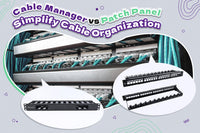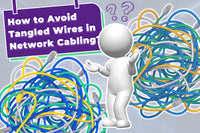Introduction
Have you ever struggled with a tight network rack or tried to run a network cable through a tight rack? Stressed to bend a Cat6 patch cord around a sharp corner, you’ve crossed paths with the concept of cable bend radius. Simply put, bend radius is the smallest curve a cable can make without harming its conductors or degrading signal quality.
Ignoring cable bend radius can result in several issues, like interference, slow data rates, and even void the cable manufacturer’s warranty. Understanding cable bend-radius basics keeps your installations fast, reliable, and compliant with industry standards.
What is Cable Bend Radius?
The cable bend radius is the smallest curvature a cable can make without damaging its inner structure, outer shielding, or compromising performance. Every network cable has a physical limit, and not respecting it can lead to damage. In other words, the cable bend radius is just the radius at which it can be bent without deteriorating. On the other side, if you maintain every bend at or above the radius, the cable will keep its shape, providing you with its best speed and ensuring durability.
The bend radius of a cable is measured from the center of the curve to the innermost edge of the cable jacket. The minimum bend radius is commonly calculated using the following formula:
Minimum Bend Radius = Outer Diameter (OD) x Standard Multiplier

Why Bend Radius Matters?
Respecting the correct cable bend radius isn’t just about avoiding bends. Meeting bend specifications is about protecting signal quality, speed and long-term reliability.
Here’s what can happen if you don’t stay below the recommended radius, take note and avoid these undesirable and avoidable consequences.
Insertion loss (attenuation)
Signals weaken more than expected. Excessive bending, stretches or compresses twisted pairs, raises attenuation by 1–3 decibels (dB) and can make a 10 GbE (10 Gigabit Ethernet that supports 10 gigabits per second) link fail.
Near-end crosstalk (NEXT) increases
Distorted twists increase near-end crosstalk (NEXT), especially at frequencies above 500 MHz. NEXT happens when a signal transmitted on one pair of wires interferes with another pair within the same cable. When a cable is bent beyond its minimum radius, particularly if it’s stretched along the curve:
- The twist rate of the pairs changes
- This modification alters the balance designed to prevent interference between pairs.
- The result is that the signal from one pair leaks into another, increasing NEXT levels.
Important Note: EMI (electromagnetic interference) can eventually be affected by how the cable is bent; EMI issues are typically not caused by it, unless the shield is damaged.
Physical damage
If you bend your cables too tightly, besides affecting the performance, it could result in permanent physical damage, such as:
- Crack or tear in the insulation layers
- Break or kink the conductors
- Fracture in fiber optic cores (in case of fiber cables)
These types of physical damage can lead to intermittent faults. These faults and difficult to trace and result in downtime.
Expert Tip: In tight spaces, use service loops and angled patch panels to avoid aggressive bends behind your equipment racks. Never neglect checking the low-temperature flexibility ratings for outdoor installations. Some cables need larger radii in cold settings.
Factors That Influence Bend Radius in the Field
There are several variables that affect how much you can safely bend a cable:
- Cable diameter & build. Thicker jackets, shields, or drain wires reduce flexibility.
- Temperature. Cables become stiffer and get brittle in cold scenarios. Always observe low-temp specs.
- Installation tension. Pulling under load temporarily raises the safe radius (up to 20 × OD for fiber) during installation.
- Routing hardware. J-hooks, trays, and grommets must match the required minimum radius for your cables. Also, avoid sharp rack punch-outs.
- Bundling. Use Velcro ties and loop straps instead of zip-ties, which can pinch pairs and flatten the cables.
Expert tip: Use a cardboard radius gauge to rapidly verify bends behind dense patch panels; no math needed in tight spaces.
Best Practices for Maintaining the Correct Cable Bend Radius
- Plan routes early. Sketch pathways and corner clearances.
- Measure twice, bend once. On-site, calculate the bend radius using the OD x multiplier.
- Use sweeping curves. Add service loops instead of a sharp turn where necessary.
- Choose proper supports. Use J-hooks that meet or exceed the minimum radius.
- Avoid over-tight ties. Hook-and-loop straps to prevent crushing maintain cable shape.
- Document turns. Note unavoidable tight turns in your documentation.
Notice: The majority of cable manufacturers include bend radius requirements in their warranty terms. Exceeding these limits can void warranties and result in failed certification tests (such as ANSI/TIA-568.0 D or ISO/IEC 11801).
Measuring and Verifying Bend Radius
- Visual loop. Bend the cable into a circle; measure the diameter, and divide by two to obtain the radius.
- Templates. Many cable reels print radius charts; keep them on-site for a quick reference.
- Certification testers. High-end analyzers can detect NEXT and return-loss anomalies caused by over-bending.
FAQ & Troubleshooting
1.I kinked a Cat6, should I replace it?
Usually, yes. An observable crease indicates the pairs are deformed. Replace the damaged section.
2.Can I relax the radius later?
Yes, you can reshape the cable into a larger loop, but never do it tighter than the specified bend radius.
3. Do patch cords follow the same rule?
Yes. Stranded cords still need 4 × OD, although the total loop size will be smaller.
4.How tightly can I curve fiber jumpers?
Standard jumpers need ≈30 mm loops; bend-insensitive fibers can go down to 7.5 mm. Always check the datasheet.
5.What’s a safe bend radius for Cat6 in-ceiling paths?
Seek the OD on the box, multiply by 4, and verify that the J-hooks or D-rings meet or exceed that number.
Conclusion
Respecting cable bend radius isn’t just good practice; it’s your ticket to speed, signal integrity, and hardware longevity. Follow TIA-568, check the manufacturer specs, and apply the tips we discussed above to keep your network for years.
As we’ve seen, the cable bend radius has effects in both the primary performance of your network and its long-term trustworthiness as well. Regardless of whether you are installing bend radius Cat6 cables in a small data center or running fiber through tight spaces, it’s mandatory to respect the manufacturer's specs to get the optimal signal integrity and diminish the risk of failure.
By understanding how over-bending can affect your deployment in the present and the future, you can avoid mistakes that would cost you time, efforts, and money.




Geben Sie als Erster einen Kommentar ab.
Hinterlasse einen Kommentar